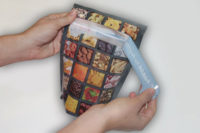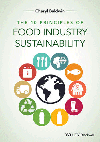
Green is the scene, and dairy processors are grappling with the concept of sustainability in their operations. With the cost of energy these days, the need to go green is as much out of cost as concern for the environment.
Packaging is one of many issues, but a significant one, since food can’t get to market without it. Luckily for processors, packaging suppliers are hard at work creating solutions to help the cause. We asked some of them what they’re up to. An extended version of this Q&A can be found at www.dairyfoods.com/dfr.
DFR: How do you define sustainable packaging?
Barbara Drillings, marketing communication manager, Seal-It Division of Printpack Inc.: We define sustainability as a journey, not a destination. … [It’s] meeting the needs of the present without compromising the future.
Brian Glasbrenner, global business and market development manager – Ingeo, NatureWorks LLC: NatureWorks was a founding member of the Sustainable Packaging Coalition (SPC). The SPC states that sustainable packaging is beneficial, safe and healthy for individuals and communities throughout its life cycle; meets market criteria for performance and cost; is sourced, manufactured, transported, and recycled using renewable energy; maximizes the use of renewable or recycled source materials; is manufactured using clean production technologies and best practices; is made from materials healthy in all probable end-of-life scenarios; is physically designed to optimize materials and energy; and is effectively recovered and utilized in biological and/or industrial cradle-to-cradle cycles.
Jill Hanegraaf, market manager, business development, Curwood Inc., a Bemis Company: We have used both Wal-Mart 7 R’s as well as the Sustainable Packaging Coalition’s definitions as a guide.
Ed Klein, vice president of environmental affairs for Tetra Pak Inc.: This boils down to what we consider the three R’s: renew, reduce and recycle. Tetra Pak cartons are 70 to 81 percent paper, a renewable resource. Tetra Pak cartons have the lowest product-to-package ratio in the liquid foods industry: 93% product and 7% packaging, as opposed to 40/60 for plastic bottles. Tetra Pak employs recycling coordinators around the country who are solely dedicated to increasing the recycling rate of our packages.
Brian Muehl, manager, materials technology, Alcan Packaging Food Americas: At Alcan, sustainable packaging is a holistic approach that considers the economic, social and environmental impact of our products and processes. …We continually work to develop packaging that ensures that our customers’ product is packaged, stored, delivered and used safely. We work to increase shelf life to minimize food waste.
Tom Shaver, vice president of marketing, North and Central America, SIG Combibloc Inc.: We believe actions to benefit our environment can only have a true impact when taken from an integrated perspective over the entire life span and value chain of our products. This is why sustainable packaging for SIG Combibloc means reducing our carbon footprint from our entire process, starting with the use of renewable resources (wood fiber), lean production processes and logistics to reduce the use of energy and finally the complete ability to recycle our packaging.
DFR: Explain the history of your company’s progress in this field.
Drillings: Seal-It is one of the only converters of heat-shrink films that offers EarthFirst PLA films … a compostable, environmentally friendly film that has all the specifications of our other films in that it prints well, shrinks extremely well and it has excellent machineability. In addition, we offer PETG Embrace HY, also considered an environmentally friendly film in its ability to be recyclable. Printpack also offers a wide range of sustainable films within its Natura family of products.
Ron Giordano, chairman and chief executive officer, H.S. Crocker Co. Inc.: [We have] over the past 10 years based every decision upon the effect it would have on raw material needs and availability of recyclability. Reduction of waste and elimination of products that create environmental concerns have a high priority in our company.
Glasbrenner: We are the first company to offer a family of commercially available low-carbon-footprint polymers derived from 100 percent annually renewable resources with cost and performance that compete with petroleum-based packaging materials and fibers. This biopolymer, Ingeo, uses 65 percent less fossil fuel to produce and emits 80 percent less greenhouse gas than traditional petroleum-based polymers.
Hanegraaf: Innovation and material science is our focus. We have always sought to provide our customers with the most efficient packaging material solutions. Our focus on thin, high-barrier packaging materials has reduced packaging material weight and volume. Innovative, proprietary high-barrier materials development has extended product shelf life reducing product throw-aways. Curwood has developed some of the thinnest OPET films on the market, providing cost benefits to our customers as well as reduced material weight and volume, leading to source reduction.
Klein: Tetra Pak has been leading the entire industry in facilitating carton recycling since 1990, and for the past seven years, climate-change mitigation and sustainable forestry have also been top initiatives for our company. Since 2002, we’ve reduced energy consumption by 27 percent at our U.S. aseptic converting plant and 15 percent at our other converting plants.
Jay Martin, vice president of operations, IPEC: IPEC made a commitment very early on by hiring a director of environmental compliance and committing to develop a continuous improvement program focused solely on sustainable packaging strategies and environmental initiatives.
Jean Moran, chief executive officer, LMI Packaging Solutions: I am confident our all plastic Eco-Lid product range is on the leading edge of sustainable packaging, not just for today, but because of the opportunities it has created for future development. Our eyes as a company have been opened to environmental awareness as a more encompassing agenda for the future.
Muehl: For Alcan, sustainability has meant commitment to customers, communities, innovation, safety and the environment. Historically, we’ve been considered as a leader in our industry. Alcan was named as one of the Global 100 Most Sustainable Corporations in the World in 2005 and 2006 and listed on the Dow Jones Sustainability World Index since 2003.
Shaver: Sustainable packaging is a long and established business principle in our company. Our environmental efforts embrace the entire value chain from sustainable forestry to efficient recycling and sensible waste management. In particular, we have launched several project innovations this year to optimize the structure of our cardboard guaranteeing the same strong barrier properties while using less resin and aluminum.
DFR: What are processors demanding from you in regards to sustainable packaging?
Drillings: In response to retailers, processors are aware that consumers are interested in saving the environment, therefore they are anxious to move in this direction. We are encouraging less labeling. One combination shrink label can take the place of two pressure-sensitive labels and a tamper-evident band.
Giordano: Increasingly, end-use customers are putting more and more demands on printers and converters of packaging materials. Large store chains are requiring more awareness of the need for sustainable packaging on the part of their suppliers, and they in turn put these same demands on the printer to deliver this type of packaging.
Glasbrenner: Organic, natural, locally produced, recyclable, compostable, free range, and environmentally friendly - these words resonate with consumers as they shop. Producers that emphasize the wholesomeness of their dairy products benefit from conveying a consistent environmentally friendly message to consumers. This means that product and package need to be in synch.
Hanegraaf: Our customers are looking for opportunities to provide packaging that is sustainable, but also delivers convenience, freshness and differentiation. They are asking about materials such as PLA and other bioresins. They are also looking for ways to make packages smaller and lighter weight while maintaining machinability, product shelf life and abuse resistance.
Moran: Our processor customers challenge LMI to continue our legacy of innovation by offering them, and their consumers, packaging enhancements that provide greater safety, convenience and package appeal while demonstrating measurable progress against the industry’s recognized sustainability scorecards. LMI’s all plastic Eco-Lid product range offers exceptionally vibrant graphic improvements compared to traditional foil based materials, in a stronger, lighter weight material. The combination of improved consumer benefits, better graphics and greater sustainability offers a tremendous platform for re-launching a brand.
Muehl: Our customers are seeking cost-effective, sustainable solutions that are practical, reliable and safe. And importantly, they are looking for sustainable solutions that protect their product. Processors are also looking at Alcan to provide metrics that properly show why one package is more sustainable than another, in terms of energy, GHG emissions or social impact.
Shaver: Not only do [processors] have to satisfy the consumer in terms of attractiveness and convenience of the packaging, they also have to maximize its value. With the increased importance of sustainable packaging there are several trade-offs to be made. However, with the rise of the aseptic carton, operators can satisfy a variety of demands with an attractive package for their consumers, offering the highest possible product quality while at the same time representing value to the processor in its operations.
DFR: How are you meeting this need? What types of products have you developed or are you developing?
Drillings: We are co-branding with Plastic Suppliers using its EarthFirst PLA film, which is made from plants, for all applications that require environmentally friendly labeling.
Giordano: Today we are 100% water-based inks, varnishes and adhesives. Our scrap, including ink buckets, are recycled. Our testing is ongoing for new ways to help the planet, including pallets from recycled corrugated. Our new non-foil lidding program has 10 years of research and testing to further the needs of our customers.
Glasbrenner: We work closely with packaging converters to ensure that Ingeo biopolymer performs to expectations as it is manufactured into films, shrink-sleeve labels, coating for ice cream cartons, bottles and jugs. All of our customers rely on NatureWorks to be at the forefront of the development of sustainable packaging.
Hanegraaf: We are meeting this need through material science and innovation. Our OPET films are some of the thinnest films available. Curwood ICE HD forming films allow downgauging from traditional nylon coextruded films providing a reduction in material weight and volume without compromising shelf life and package integrity. Our self-manufactured Curpolene 7201/7202 films deliver superior protection, yet are 10% lighter and have 13% less volume than conventional films. You also get 18% more packages per roll resulting in fewer roll changeovers, greater machine uptime, fewer trucks required, less warehouse space needed and less packaging waste. Curwood has also delivered sustainable innovation in shrink bags with the introduction of our Eco-Tite Shrink bags for cheese.
Klein: Tetra Pak cartons help manufacturers increase their resource efficiency and decrease their carbon footprint. … Tetra Pak’s paper cartons require less energy and fewer trips to transport than other packaging options. Products packaged in Tetra Pak cartons can be stored up to 12 months without refrigeration, saving additional energy and eliminating carbon emissions associated with powering the refrigeration process.
Martin: IPEC offers free consulting services to our customers on how to optimize their freight through several different packaging initiatives … IPEC also offers free consulting service for any of our customers that are putting in place a formal sustainable initiatives program and are pursuing environmental industry accreditations, such as ISO 14001, Project Clean Sweep, etc. IPEC introduced several new product lines in 2007 and 2008. All were approached from the perspective to utilize the newest technology in production to efficiently produce the most amount of product with the least environmental impact and least amount of scrap.
Moran: LMI’s introduction in 2005 of its’ Eco-Lid product range offers compatibility with metal detection equipment, is lighter in weight and seals at lower temperatures for lower energy use. Since 2005 LMI has added new material options, such as a transparent material for product visibility, as well as new formats to meet growing demands for single-serve, portion-control packaging uses.
Muehl: Alcan is a leader in the practice of “down-gauging,” an exciting and cost-effective way of reducing the environmental footprint of packaging. They require less energy and emit fewer GHGs. We are working with our customers to redesign package sizes and shapes to improve cube efficiency and reduce unused package space. We are moving away from PVDC. We have pioneered the use of Ceramis-PLA, the first biodegradable high-barrier film.
Shaver: The aseptic carton board optimization, and reducing the amounts of PE and aluminum required to deliver the same packaging integrity results, is an integral part of our total quality approach.
DFR: In your opinion, what is the current state of sustainable packaging and where does it need to go next?
Drillings: As consumer awareness increases, the importance of packaging being environmentally friendly will be even more important. We are always researching new films and other ways to ensure that we are on the cutting edge of sustainable packaging.
Giordano: The current status of sustainable packaging is in a state of expansion and growth accompanied with the realization of what can be a proven economical method in which to attain these goals.
Glasbrenner: Today, the focus is on single-attribute characteristics, i.e., renewable, recyclable, using less material, reduction. Industry needs to refocus toward a systems view, and is making strides to do so. …If you look at the state of sustainable packaging today, we have the materials and the knowledge framework. The next great step forward will be to improve the infrastructure for recovery and reuse. … The packaging industry needs to do a better job of educating its customers on life-cycle thinking. Furthermore, the packaging industry must partner more closely with its customers so that there is no gap between the wholesomeness of a dairy product and the environmental friendliness of its packaging.
Hanegraaf: Both suppliers and purchasers of have been on a huge learning curve as far as sustainability and sustainable packaging are concerned. The market has widened that focus to include other solutions like right-sizing packages, using thinner materials, eliminating unnecessary packaging and reducing waste. Sustainable packaging is really a continuum, not a destination.
Klein: There is strong consumer interest in sustainable packaging today. According to a 2006 study by NMI, 65 percent of the conventional consumer market considers environmentally friendly packaging very to somewhat important when making purchasing decisions. Tetra Pak is committed to increasing curbside carton recycling in the U.S by 50 percent by 2012.
Martin: Companies must make certain not to lose momentum by putting in place individual projects that are not tied to a long-term continual improvement plan. In order for these program to be effective, management teams must continue to allocate funding and employee time in order to achieve the long-term sustainable goals.
Moran: The current state of sustainable packaging is in its infancy. Increasing consumer awareness of global environmental trends will drive processors and ultimately material suppliers like LMI to develop and offer products that are more recyclable and renewable. These innovations and advancements will in turn create increasing awareness of the role we all play in impacting our environment and will feed future innovation.
Muehl: Because of high gasoline prices and consumer demand, sustainability will take an even more visible place in the market. Consumer education might be the next step. For the packaging industry, sustainability will mean new technologies, new approaches and new materials.
Shaver: Sustainable packaging is clearly on the rise and its demand will continue to grow in the future. Judging from a total cost perspective over the entire value chain, the aseptic carton offers the lowest cost solution. More research and studies are to be dedicated to using less raw materials, utilizing more renewable resources and producing less waste for the aseptic carton packaging.






